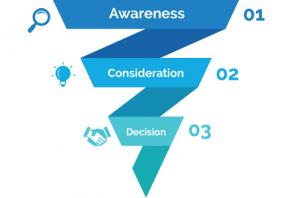What is the buyer’s journey?
The buyer’s journey is the process that individuals go through when deciding to purchase a product or service. Most buyers today can find all the information they need about a business right at their fingertips. Therefore, knowing and understanding the journey they go through is an important sales and marketing tactic that is constantly changing and evolving.
The majority of buys find the information they need to make purchase decisions on their own, via the internet and social media. Most of the time they already have an opinion formed before they even reach out to the business. How do you persuade or change their minds before the opinion is formed? The answer is to understand the customer and providing them with the information they need to make the right decision. The stages of the buyer’s journey consist of the Awareness Stage, the Consideration Stage, and the Decision Stage. In this blog, we dig into the actions that sales and marketing persons should be taken to nudge the buyer in the right direction.


The Awareness Stage
In this stage, buyers are experiencing a problem or goal and are searching for a way to solve it. These problems can be typically anything, and they may be looking to finding information and resources to help them find a solution.
The key to providing the right information and resources to those buyers is by asking the following questions: What is their problem or goal? How are they describing their problem or goal? And where are they looking to find a solution to the problems or goals? When you know your business has the solutions to the buyer’s problems, marketers must create informational content and provide resources that buyers can access easily. This can be done through blogs, social media content, infographics, guides, and anything that will help them get to the next step.
The Consideration Stage
This is where buyers have defined their problem or goal and are ready to address it. This is when they begin weighing their options to solve the problem or pursue the goal.
The sales and marketing team must now understand what are the options the buyer is looking into? How they are educating themselves on the different options and what the pros and cons are of these options. Understanding how your products and services can solve their problems along with researching how competitors are influencing buyer’s perception can help to create an effective strategy. Providing how-to videos, online Q&As, and webinars make great content for buyers to understand your product and service better.
The Decision Stage
Now buyers are evaluating providers to solve their problems, they may have criteria and concerns. When they look to your company for their needs you have to understand their requirements and what they like compared to other providers.
You now must show that your products or services are unique and what sets you apart from the competition. How will your brand provide the best value to buyers? Providing case studies, customer reviews, free trials, and demos will help show your credibility and trustworthiness. Attention to detail and keeping buyers informed will help you turn leads into customers. Once you’ve created a relationship with potential customers you must follow up and continue to optimize all resources such as search engines, social media, and email campaigns.
Staying in contact and providing information maximizes conversation to value and will encourage them to choose you as their provider over others.
